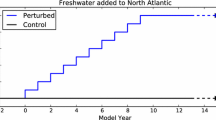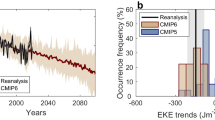Abstract
Dominant summertime disturbances along the subtropical Meiyu front are eastward-propagating synoptic-scale waves coupled with precipitation and moisture under a moderate background vertical shear. To what extent the intensity and structure of such synoptic disturbances would change under global warming is investigated by diagnosing 18 models from Phase 6 of the Coupled Model Intercomparison Project (CMIP6). The model diagnosis reveals that there is a robust increase in the intensity of synoptic-scale motions along the Meiyu front, while the wavelength and phase speed remain unchanged. The cause of such changes of the synoptic-scale variability in the future warmer climate is investigated through the analysis of a moist baroclinic instability model. It is found that the growth rate of the most unstable mode strengthens in the future warmer climate, while the zonal wavenumber and phase speed of the most unstable mode remain unchanged, which is consistent with the CMIP6 projections. The enhanced synoptic-scale variability is primarily attributed to the increase of background meridional and vertical moisture gradients under a warmer climate through strengthened positive moisture-convection-circulation feedback, while the changes of background vertical shear and convective adjustment times are insignificant.










Similar content being viewed by others
Data availability
The CMIP6 model outputs are available from https://esgf-node.llnl.gov/projects/cmip6/. The Global Precipitation Climatology Project (GPCP) data can be obtained from https://www.ncdc.noaa.gov/wdcmet/data-access-search-viewer-tools/global-precipitation-climatology-project-gpcp-clearinghouse. The ERA5 reanalysis data can be downloaded from https://climate.copernicus.eu/climate–reanalysis.
References
Betts AK (1986) A new convective adjustment scheme. Part I: observational and theoretical basis. Q J R Meteorol Soc 112:667–691. https://doi.org/10.1002/qj.49711247307
Betts AK, Miller MJ (1986) A new convective adjustment scheme. Part II: single column tests using GATE wave, BOMEX, ATEX and arctic air-mass data sets. Q J R Meteorol Soc 112:693–709. https://doi.org/10.1002/qj.49711247308
Charney JG (1947) The dynamics of long waves in a baroclinic westerly current. J Meteorol 4:135–162. https://doi.org/10.1175/1520-0469(1947)004%3c0136:TDOLWI%3e2.0.CO;2
Eady ET (1949) Long waves and cyclone waves. Tellus 1:33–52. https://doi.org/10.3402/tellusa.v1i3.8507
Eyring V, Bony S, Meehl GA, Senior GA, Stevens B, Stouffer RJ, Taylor KE (2016) Overview of the Coupled Model Intercomparison Project Phase 6 (CMIP6) experimental design and organization. Geosci Model Dev 9:1937–1958. https://doi.org/10.5194/gmd-9-1937-2016
Fowlis WW, Hide R (1965) Thermal convection in a rotating annulus of liquid: effect of viscosity on the transition between axisymmetric and non-axisymmetric flow regimes. J Atmos Sci 22:541–558. https://doi.org/10.1175/1520-0469(1965)022%3c0541:TCIARA%3e2.0.CO;2
Held IM, Soden BJ (2006) Robust responses of the hydrological cycle to global warming. J Clim 19(21):5686–5699. https://doi.org/10.1175/JCLI3990.1
Hersbach H, Bell B, Berrisford P, Hirahara S, Horányi A, MuñozSabater J et al (2020) The ERA5 global reanalysis. Q J R Meteorol Soc 146(730):1999–2049. https://doi.org/10.1002/qj.3803
Holton JR (2004) An introduction to dynamic meteorology, 4th edn. Elsevier Academic, p 535
Huffman GJ, Adler RF, Morrissey MM, Bolvin DT, Curtis S, Joyce R, McGavock B, Susskind J (2001) Global precipitation at one-degree daily resolution from multisatellite observations. J Hydrometeorol 2(1):36–50. https://doi.org/10.1175/1525-7541(2001)002%3c0036:GPAODD%3e2.0.CO;2
Kang SM, Lu J (2012) Expansion of the Hadley cell under global warming: Winter versus summer. J Clim 25(24):8387–8393. https://doi.org/10.1175/JCLI-D-12-00323.1
Kanno Y, Iwasaki T (2022) Future changes of atmospheric energy cycle in CMIP5 climate models. J Geophys Res Atmos. https://doi.org/10.1029/2021JD036380
Lehmann J, Coumou D, Frieler K, Eliseev AV, Levermann A (2014) Future changes in extratropical storm tracks and baroclinicity under climate change. Environ Res Lett 9(8):084002. https://doi.org/10.1088/1748-9326/9/8/084002
Lu J, Chen G, Frierson DM (2008) Response of the zonal mean atmospheric circulation to El Niño versus global warming. J Clim 21(22):5835–5851. https://doi.org/10.1175/2008JCLI2200.1
Lu J, Vecchi GA, Reichler T (2007) Expansion of the Hadley cell under global warming. Geophys Res Lett 34:L06805. https://doi.org/10.1029/2006GL028443
Park JH, An SI (2014) Southward displacement of the upper atmosphere zonal jet in the eastern north Pacific due to global warming. Geophys Res Lett 41(22):7861–7867. https://doi.org/10.1002/2014GL062175
Pedlosky J (1964) An initial value problem in the theory of baroclinic instability. Tellus 16:12–17. https://doi.org/10.3402/tellusa.v16i1.8892
Phillips NA (1954) Energy transformations and meridional circulations associated with simple baroclinic waves in a two-level, quasi-geostrophic model. Tellus 6:273–286. https://doi.org/10.3402/tellusa.v6i3.8734
Shaw TA, Baldwin M, Barnes EA, Caballero R, Garfinkel CI, Hwang YT, Li C, O’gorman PA, Rivière G, Simpson IR, Voigt A (2016) Storm track processes and the opposing influences of climate change. Nat Geosci 9(9):656–664. https://doi.org/10.1038/ngeo2783
Smagorinsky J, Manabe S, Holloway JL (1965) Numerical results from a nine-level general circulation model of the atmosphere. Mon Weather Rev 93:727–768. https://doi.org/10.1175/1520-0493(1965)093%3c0727:NRFANL%3e2.3.CO;2
Walker CC, Schneider T (2006) Eddy influences on Hadley circulations: simulations with an idealized GCM. J Atmos Sci 63(12):3333–3350. https://doi.org/10.1175/JAS3821.1
Wang B, Chen G (2017) A general theoretical framework for understanding essential dynamics of Madden–Julian oscillation. Clim Dyn 49:2309–2328. https://doi.org/10.1007/s00382-016-3448-1
Wang B, Li T (1993) A simple tropical atmosphere model of relevance to short-term climate variations. J Atmos Sci 50:260–284. https://doi.org/10.1175/1520-0469(1993)050%3c0260:ASTAMO%3e2.0.CO;2
Wu Y, Ting M, Seager R, Huang HP, Cane MA (2011) Changes in storm tracks and energy transports in a warmer climate simulated by the GFDL CM2. 1 model. Clim Dyn 37(1):53–72. https://doi.org/10.1007/s00382-010-0776-4
Yang G, Li T (2022) Moist baroclinic instability along the subtropical Meiyu front. J Clim (accepted)
Acknowledgements
The authors acknowledge the World Climate Research Programme’s Working Group on Coupled Modelling and the climate modelling groups for producing and making available their model output. The authors thank the Earth System Grid Federation (ESGF) for archiving the data and providing access, and the multiple funding agencies who support CMIP6 and ESGF. The authors acknowledge the European Centre for Medium-Range Weather Forecasts for providing the ERA5 reanalysis data. The authors acknowledge the Global Precipitation Climatology Project for providing the precipitation data used in the study.
Funding
This work was jointly supported by NSFC grant 42088101, NOAA NA18OAR4310298, and NSF AGS-2006553. This is SOEST contribution number 11596 and IPRC contribution number 1583.
Author information
Authors and Affiliations
Contributions
All authors designed the study. GY performed the analysis and prepared figures. GY wrote the main manuscript. All authors discussed the results and revised the manuscript.
Corresponding author
Ethics declarations
Conflict of interest
The authors declare that they have no conflicts of interest.
Additional information
Publisher's Note
Springer Nature remains neutral with regard to jurisdictional claims in published maps and institutional affiliations.
Rights and permissions
Springer Nature or its licensor (e.g. a society or other partner) holds exclusive rights to this article under a publishing agreement with the author(s) or other rightsholder(s); author self-archiving of the accepted manuscript version of this article is solely governed by the terms of such publishing agreement and applicable law.
About this article
Cite this article
Yang, G., Li, T. Increased synoptic variability along the subtropical Meiyu front under global warming. Clim Dyn 61, 295–308 (2023). https://doi.org/10.1007/s00382-022-06554-0
Received:
Accepted:
Published:
Issue Date:
DOI: https://doi.org/10.1007/s00382-022-06554-0




